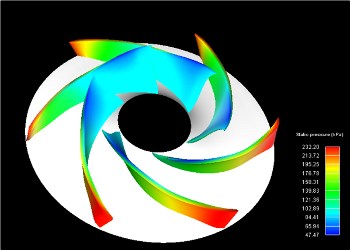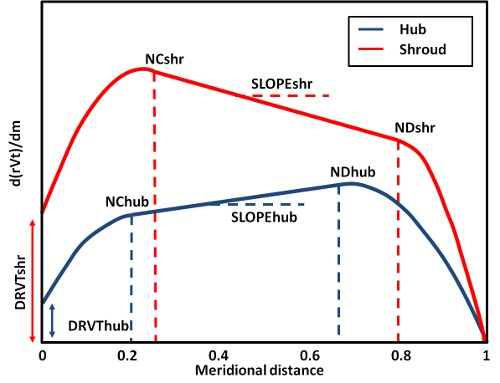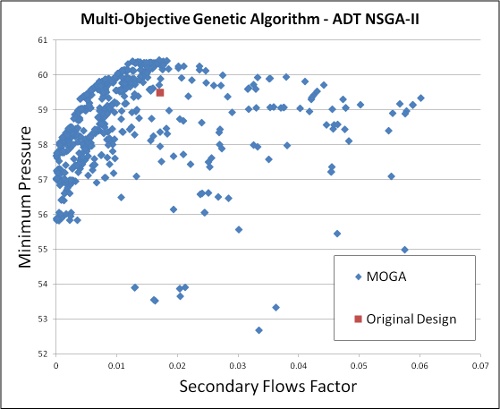You are here
Turbomachinery efficiency and emissions reduction through automatic optimization
Learn the advantages of 3D inverse design.
You hear about it everywhere: design optimization. The world requires more and more efficient and reduced emissions products, as with the U.S. Environmental Protection Agency Engine Testing Regulations and European Commission Ecodesign Directive. Wouldn't it be great to automate your pump design optimization? You can by using three-dimensional 3D inverse design technology.

Impeller: Surface static pressure on a 3D impeller designed with TURBOdesign1; the 3D inviscid solution allows hydrodynamic performance evaluation prior to any 3D CFD analysis.
Efficiency levels for many turbomachinery applications have matured in recent years, in part because of new regulations. The introduction of computational fluid dynamics (CFD) in the design process led to significant improvement in performance, but further improvements are increasingly more difficult to achieve. The conventional design process, which is based on iterative changes to geometry, relies heavily on previous design experience and tends to encourage designers to stay within their comfort zones. This can limit design efficiency, making it more difficult to achieve significant breakthroughs or to meet the demanding multi-objective/multi-point/multi-disciplinary requirements of modern turbomachinery, including pumps.
Design objectives in turbomachinery contrast in many ways. Consider aerodynamic efficiency and structural integrity.
For example, a thinner blade can be more efficient but at the expense of poorer structural performances. In principle, all turbomachinery applications share common challenges, whether one looks at multi-disciplinary problems, such as aerodynamic with mechanical performance, noise and efficiency in fans and compressors, or good suction performance subject to minimum shut-off head and high efficiency at different operating points in pumps. Robust design optimization must also be considered, the aim being to make the design performances less dependent on operating changes. Automatic optimization can help find solutions to all of these design challenges.
The key in using optimization in design is to explore the design space as widely as possible. Gradient-type methods are faster computationally but tend to find local minima. The goal, then, is to use evolutionary-type approaches such as Genetic Algorithm (GA) that can explore the design space widely and find global minima of objective functions.
GA also copes well with multi-objective criteria and creates Pareo-optimal fronts that show tradeoffs between different design parameters. Having trade-off information is useful for designers and helps them provide customized solutions. However, GA requires a large number of objective function evaluations typically running into thousands. Since many problems are multi-point, this makes the application of GA coupled with full computational fluid dynamics (CFD) or finite element analysis (FEA) rather expensive computationally.
Another alternative is to use some form of surrogate model. In this approach, a design matrix is generated by using Design of Experiments (DoE), which is then used to create a surrogate model through a quadratic regression (Response Surface Model) or other methods, such as artificial Neural Network or Kriging. These surrogate models can then be validated, and, if accurate enough, then GA can be run on these models, saving considerably in computational time as each CFD or FEA evaluation simply becomes a polynomial evaluation. However, in general, accurate surrogate models can only be obtained with a handful of design parameters. Larger numbers of design parameters can result in higher surrogate model errors.
The keys to making automatic optimization part of a commercial product development are 3D geometry parameterization and the number of input design parameters. One piece of blade geometry parameterized by just 30 parameters requires close to 600 to 800 designs to be evaluated just for the initial DoE database. Even with high computational capabilities, this is not something that allows for a design to be developed in a few weeks.
In contrast, parameterization of the same geometry via 3D inverse design methods can be done with six to 10 parameters. This means only 40 to 100 designs are needed -- basically reducing the number of computations by factors of 10 to 20.
So, how is blade geometry parameterized via 3D inverse design?
Different approaches are used for blade geometry parameterization. In axial machines, it is customary to use some of form of surface definition, while, in many radial and mixed-flow applications, generally the blade angle is used to control the camber distribution. This is done using a number of control points between leading edge to trailing edge on 2D sections that are then stacked together to form a 3D geometry.
In 3D inverse design, users parameterize the blade loading, or pressure jump across the blade. The implementation is such that four to eight parameters of blade loading can cover as much design space as 30+ parameters required when using blade shape directly. This reduction in design parameters makes the application of a surrogate model a practical reality for 3D design.

Loading: Parameterized blade loading, or pressure jump across the blade, where four to eight parameters are equivalent to 30 to 80 geometrical blade parameters.

Pareto: Multi-objective optimization of a centrifugal pump for high efficiency and good cavitation performance. Hundreds of designs can be run in just a couple of hours.
When taking time and cost into consideration, 3D inverse design technology proves to provide the clear advantage in achieving turbomachinery efficiency and emissions reduction via automatic optimization. Examples have been widely published. In the pump industry, Carver Pumps in the United States and Ebara Corporation in Japan have successfully applied this method. Also, McQuay in the United States presented the application of coupled 3D inverse design with DoE for optimization of a centrifugal compressor stage for the refrigeration industry. Find out more aboout about 3D inverse design technology and TURBOdesign Suite.
- ADT's blog
- Log in or register to post comments
- 2713 reads



Recent comments